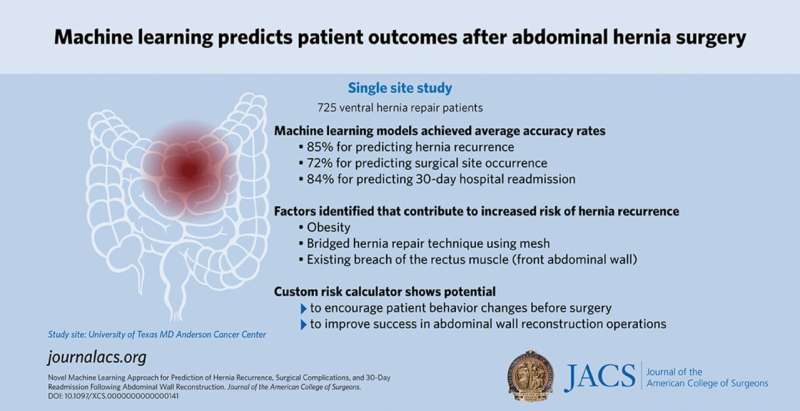Credit: American College of Surgeons
Machine learning (ML) models developed by surgeons at the University of Texas MD Anderson Cancer Center in Houston have shown a high level of accuracy in predicting which types of patients are most likely to have a hernia recurrence or other complications. Research findings are reported in an "article in press" published on the website of the Journal of the American College of Surgeons (JACS).
Repair of ventral hernias—hernias that occur when a bulge emerges through the abdominal muscles—is a common operation, with more than 400,000 performed annually in the U.S. However, more than a third of these types of hernias end up happening again or patients experience some other type of postsurgery complication.1,2
"We found that the machine learning algorithm, trained by using our own data, could accurately predict occurrence of complications after complex abdominal wall repair," said lead study author Abbas M. Hassan, MD, postdoctoral fellow and Ph.D. candidate, department of plastic surgery, MD Anderson. "It was also able to identify factors associated with poor outcomes."
Dr. Hassan and colleagues say this is the first study to describe the use of ML to predict postsurgery complications of abdominal wall reconstruction.
Ventral hernias can occur in patients who've had an abdominal operation for something other than hernia repair, such as gall bladder removal or, in many cases at MD Anderson, to remove a tumor and nearby tissue, or even part of an organ. The surgeons noted that with more than 4 million abdominal operations performed in the United States annually, the demand for abdominal wall reconstruction is growing.3
About the study
The researchers reviewed 725 patients who underwent an open operation for ventral hernia repair at MD Anderson from March 1, 2005 to June 30, 2019. Postsurgery outcomes included hernia recurrence, surgical site occurrence, and hospital readmission within 30 days after initial discharge.
The study team, led by senior author Charles E. Butler, MD, FACS, used the data from those 725 patients to develop nine supervised ML algorithms that they found successfully predicted outcomes. The models considered patient demographics and characteristics, such as smoking status and other health conditions. The models also considered patient outcomes and characteristics of the operation itself, such as surgical technique. Dr. Butler is the tenured professor and chairman of plastic surgery and the Charles B. Barker Endowed Chair in Surgery at MD Anderson.
Credit: American College of Surgeons
Accuracy rates and identified risk factors
The ML models achieved average accuracy rates as follows:
- 85% for predicting hernia recurrence
- 72% for predicting surgical site occurrence
- 84% for predicting 30-day hospital readmission
A deeper analysis found that factors that contributed an increased risk of hernia recurrence were an existing breach of the rectus muscle of the front abdominal wall, obesity, and the bridged repair technique, which uses mesh to span the hernia defect.
Study insights
Dr. Butler explained the rationale for developing the ML models. "It's really important for surgeons to understand what the risk factors are to abdominal wall reconstruction," he said. "It is such a common problem that surgeons have to deal with in just about every subspecialty of surgery. It puts tremendous financial, emotional, and physical strains on the healthcare system and on the patients that are affected as well as the surgeons dealing with these problems."
Many patients experience discomfort and distress if they develop a hernia as well as if their hernia recurs after an operation to repair it fails. "Any information that we can have to help predict some of these adverse outcomes and potentially avoid or mitigate them will be a huge benefit to the patients, their outcomes, and to the financial well-being of the healthcare system," Dr. Butler said.
Dr. Hassan noted research that has shown that a 1% reduction in the rate of hernia recurrence alone would save the U.S. healthcare system $30 million, according to a 2012 study. "Reduction in complications is really one of the paramount goals of abdominal wall reconstruction," Dr. Hassan said. "Patients who develop a complication may require readmission or reoperation, and this results in increased morbidity and mortality and healthcare costs, as well as reduced quality of life. So, this becomes a critical concern when we care for patients with cancer who are immunocompromised."
Reducing risk factors that lead to complications
Dr. Butler said the goal is to incorporate an even broader dataset into the ML models and construct risk calculators that can help surgeons more clearly identify patients who are most susceptible to complications after ventral hernia repair and potential risk factors that can be modified to improve their chances of success. "And then you can have a frank discussion in real time and set goals with patients," he said. "For example, you can use the risk calculator to explain to the patient that your chance of hernia recurrence will go down by a certain percent if you lose weight, reduce your HbA1c, and stop smoking. Also, your risk of having a surgical site occurrence by doing those things will go down by a different tangible percent." This approach gives patients accurate, tangible goals and provides realistic motivation to actively participate in improving their own outcomes of abdominal wall reconstruction.
"We believe the models can be improved and made to be more generalizable in subsequent iterations, and we're currently embarking on a multicenter study to validate the models and develop a first-of-its-kind integrated tool that uses these models and clinical data and imaging data to provide a robust prediction tool," Dr. Hassan said. "Our hope is that this tool will be integrated in the future in the electronic medical record and mobile interfaces."
More information: Hassan, Abbas M et al, Novel Machine Learning Approach for the Prediction of Hernia Recurrence, Surgical Complication, and 30-Day Readmission after Abdominal Wall Reconstruction, Journal of the American College of Surgeons (2022). DOI: 10.1097/XCS.0000000000000141
Journal information: Journal of the American College of Surgeons
Provided by American College of Surgeons























